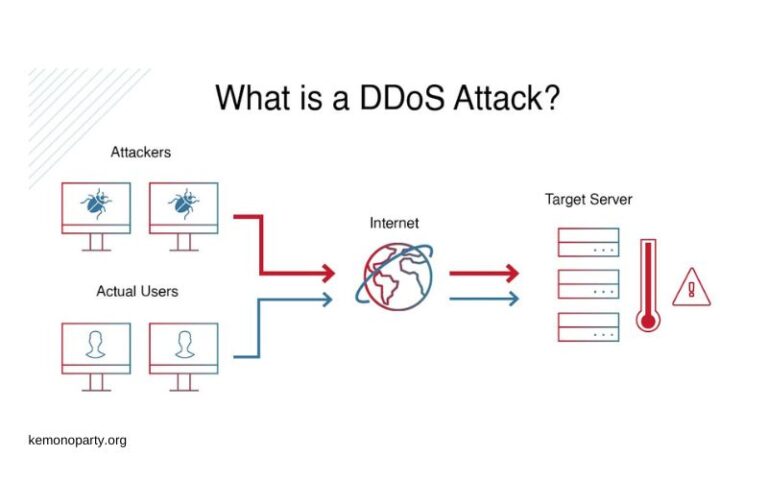In the ever-evolving world of cybersecurity, one threat that has gained significant attention in recent years is the Kemono Party DDoS (Distributed Denial of Service) attack. As the digital landscape continues to expand, understanding the nature, origin, and impact of these attacks has become crucial for businesses and individuals alike. This article aims to provide a comprehensive overview of Kemono Party DDoS, its underlying mechanisms, and the strategies for mitigating the associated risks.
What is a DDoS Attack?
Before delving into the specifics of Kemono Party DDoS, it’s essential to understand the broader concept of a DDoS attack. A DDoS attack is a malicious attempt to disrupt the normal functioning of a website, server, or network by overwhelming it with a flood of traffic from multiple sources. This influx of traffic can effectively render the targeted system inaccessible to legitimate users, causing significant disruption and potential financial losses.
Kemono Party DDoS: Origin and Impact
The Kemono Party DDoS attacks have their origins in the online subculture of “Kemono,” a term that refers to anthropomorphic animal characters. These attacks have been primarily associated with the Kemono community, though the exact motivations behind them are not always clear. The impact of Kemono Party DDoS attacks can be far-reaching, affecting businesses, organizations, and even individuals who may be perceived as targets by the perpetrators.
Understanding the Motives Behind Kemono Party DDoS
The motives behind Kemono Party DDoS attacks can be complex and multifaceted. Some researchers suggest that these attacks may be driven by a desire for attention, retaliation, or even a sense of community within the Kemono subculture. However, it’s important to note that the motivations can vary, and understanding the underlying factors is crucial for developing effective mitigation strategies.
The Consequences of Kemono Party DDoS Attacks
The consequences of Kemono Party DDoS attacks can be severe, ranging from temporary website outages to more prolonged service disruptions. These attacks can lead to significant financial losses, reputational damage, and even legal implications for the targeted organizations. In some cases, the impact can extend beyond the immediate target, affecting related services and the broader digital ecosystem.
Protecting Against Kemono Party DDoS Attacks
Safeguarding against Kemono Party DDoS attacks requires a multi-layered approach that combines technical, organizational, and human-centric measures. This includes implementing robust network security protocols, maintaining up-to-date software and systems, and fostering a culture of cybersecurity awareness within the organization.
Steps to Mitigate the Risks of Kemono Party DDoS Attacks
To effectively mitigate the risks of Kemono Party DDoS attacks, organizations should consider the following steps:
- Implement DDoS Mitigation Solutions: Invest in specialized DDoS mitigation services or solutions that can detect and effectively respond to such attacks, reducing the impact on your systems and services.
- Enhance Network Monitoring and Incident Response: Develop and regularly review your incident response plan, ensuring your team is prepared to swiftly identify, contain, and recover from Kemono Party DDoS attacks.
- Educate Employees and Raise Awareness: Provide comprehensive cybersecurity training to your employees, equipping them with the knowledge and skills to recognize and respond to Kemono Party DDoS threats.
- Collaborate with Industry Peers and Authorities: Engage with industry organizations, security experts, and law enforcement agencies to stay informed about the latest Kemono Party DDoS trends and best practices for prevention and response.
The Role of Cybersecurity in Preventing Kemono Party DDoS Attacks
Cybersecurity professionals play a crucial role in safeguarding organizations against Kemono Party DDoS attacks. By implementing robust security measures, conducting risk assessments, and staying vigilant, cybersecurity teams can help mitigate the impact of these threats and ensure the continued availability and reliability of critical systems and services.
Case Studies of Organizations Affected by Kemono Party DDoS Attacks
To illustrate the real-world implications of Kemono Party DDoS attacks, consider the following case studies:
- The Gaming Platform Outage: A popular online gaming platform was hit by a Kemono Party DDoS attack, leading to several hours of service disruption and significant financial losses due to lost revenue and user frustration.
- The E-commerce Site Shutdown: An e-commerce website was targeted by a Kemono Party DDoS attack, causing a complete shutdown of the platform for an extended period. This resulted in lost sales, damaged customer trust, and long-term reputational harm.
- The Non-profit Organization Incident: A non-profit organization dedicated to animal welfare was subjected to a Kemono Party DDoS attack, which impacted their ability to process donations and communicate with their supporters, ultimately hindering their mission.
Conclusion
As the digital landscape continues to evolve, the threat of Kemono Party DDoS attacks is likely to persist and even evolve. By understanding the nature of these attacks, their underlying motivations, and the strategies for effective mitigation, organizations can better prepare themselves to navigate the turbulent waters of cybersecurity. Embracing a proactive, collaborative, and resilient approach will be crucial in safeguarding against the ever-changing landscape of Kemono Party DDoS threats.
To learn more about protecting your organization from Kemono Party DDoS attacks, consider consulting with a cybersecurity expert or exploring our comprehensive security solutions.


